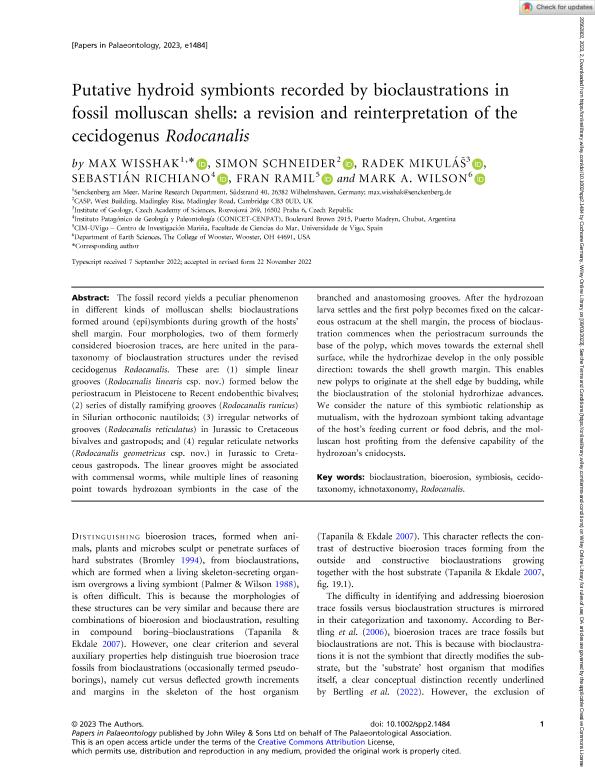Mostrar el registro sencillo del ítem
dc.contributor.author
Wisshak, Max
dc.contributor.author
Schneider, Simon
dc.contributor.author
Mikulás, Radek

dc.contributor.author
Richiano, Sebastián Miguel

dc.contributor.author
Ramil, Fran
dc.contributor.author
Wilson, Mark A.
dc.date.available
2024-04-23T11:44:28Z
dc.date.issued
2023-03
dc.identifier.citation
Wisshak, Max; Schneider, Simon; Mikulás, Radek; Richiano, Sebastián Miguel; Ramil, Fran; et al.; Putative hydroid symbionts recorded by bioclaustrations in fossil molluscan shells: a revision and reinterpretation of the cecidogenus Rodocanalis; John Wiley & Sons; Papers in Palaeontology; 9; 2; 3-2023; 1-21
dc.identifier.issn
2056-2802
dc.identifier.uri
http://hdl.handle.net/11336/233840
dc.description.abstract
The fossil record yields a peculiar phenomenon in different kinds of molluscan shells: bioclaustrations formed around (epi)symbionts during growth of the hosts´ shell margin. Four morphologies, two of them formerly considered bioerosion traces, are here united in the parataxonomy of bioclaustration structures under the revised cecidogenus Rodocanalis. These are: (1) simple linear grooves (Rodocanalis linearis csp. nov.) formed below the periostracum in Pleistocene to Recent endobenthic bivalves; (2) series of distally ramifying grooves (Rodocanalis runicus) in Silurian orthoconic nautiloids; (3) irregular networks of grooves (Rodocanalis reticulatus) in Jurassic to Cretaceous bivalves and gastropods; and (4) regular reticulate networks (Rodocanalis geometricus csp. nov.) in Jurassic to Cretaceous gastropods. The linear grooves might be associated with commensal worms, while multiple lines of reasoning point towards hydrozoan symbionts in the case of the branched and anastomosing grooves. After the hydrozoan larva settles and the first polyp becomes fixed on the calcareous ostracum at the shell margin, the process of bioclaustration commences when the periostracum surrounds the base of the polyp, which moves towards the external shell surface, while the hydrorhizae develop in the only possible direction: towards the shell growth margin. This enables new polyps to originate at the shell edge by budding, while the bioclaustration of the stolonial hydrorhizae advances. We consider the nature of this symbiotic relationship as mutualism, with the hydrozoan symbiont taking advantage of the host´s feeding current or food debris, and the molluscan host profiting from the defensive capability of the hydrozoan´s cnidocysts.
dc.format
application/pdf
dc.language.iso
eng
dc.publisher
John Wiley & Sons

dc.rights
info:eu-repo/semantics/openAccess
dc.rights.uri
https://creativecommons.org/licenses/by/2.5/ar/
dc.subject
BIOCLAUSTRATION
dc.subject
BIOEROSION
dc.subject
CECIDOTAXONOMY
dc.subject
ICHNOTAXONOMY
dc.subject
RODOCANALIS
dc.subject
SYMBIOSIS
dc.subject.classification
Paleontología

dc.subject.classification
Ciencias de la Tierra y relacionadas con el Medio Ambiente

dc.subject.classification
CIENCIAS NATURALES Y EXACTAS

dc.title
Putative hydroid symbionts recorded by bioclaustrations in fossil molluscan shells: a revision and reinterpretation of the cecidogenus Rodocanalis
dc.type
info:eu-repo/semantics/article
dc.type
info:ar-repo/semantics/artículo
dc.type
info:eu-repo/semantics/publishedVersion
dc.date.updated
2024-04-22T11:53:36Z
dc.journal.volume
9
dc.journal.number
2
dc.journal.pagination
1-21
dc.journal.pais
Países Bajos

dc.description.fil
Fil: Wisshak, Max. No especifíca;
dc.description.fil
Fil: Schneider, Simon. No especifíca;
dc.description.fil
Fil: Mikulás, Radek. Czech Academy of Sciences; República Checa
dc.description.fil
Fil: Richiano, Sebastián Miguel. Consejo Nacional de Investigaciones Científicas y Técnicas. Centro Científico Tecnológico Conicet - Centro Nacional Patagónico. Instituto Patagónico de Geología y Paleontología; Argentina
dc.description.fil
Fil: Ramil, Fran. Universidad de Vigo; España
dc.description.fil
Fil: Wilson, Mark A.. The College of Wooster; Estados Unidos
dc.journal.title
Papers in Palaeontology
dc.relation.alternativeid
info:eu-repo/semantics/altIdentifier/doi/http://dx.doi.org/10.1002/spp2.1484
Archivos asociados
